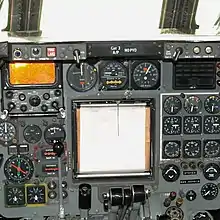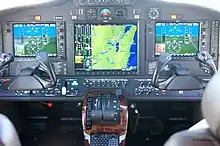Moving map display
A moving map display is a type of navigation system output that, instead of numerically displaying the current geographical coordinates determined by the navigation unit or an heading and distance indication of a certain waypoint, displays the unit's current location at the center of a map. As the unit moves around and new coordinates are therefore determined, the map moves to keep its position at the center of the display. Mechanical moving map displays using paper charts were first introduced in the 1950s, and became common in some roles during the 1960s. Mechanically moved paper maps were replaced by projected map displays[1][2] and digital maps during the 1970s and 80s, with resolution and detail improving along with computer imagery and the computer memory systems that held the data.



A common example of a moving map display today is the map display in a smart phone, which uses GPS to determine its current position and then recalls the map data from the device's memory or from the Internet in real time. A symbol representing the location of the GPS device carried by a person or inside a vehicle, remains stationary on the display screen while a map or chart image moves beneath the symbol.[3] The display thus portrays the physical movement of the device on the displayed map or chart. The portrayal typically shows a simulated overhead view of the device location on the moving map, but some devices also simulate a three-dimensional view from the perspective of the device.
Many devices also provide an option for the map or chart image to remain stationary on the display while the location symbol moves to represent physical device movement. Some moving map display systems also provide a method of displaying the elevation of the device above sea level or the earth's surface.